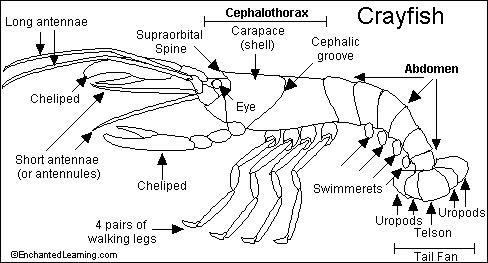
 |
| You might also like: | Label Crayfish External Diagram Printout | Crayfish Find it! Quiz: Student Research Activity | Lobster Printout | Copepod Printout | Shrimp Printout | Today's featured page: Food Chain: Cloze Activity |
| EnchantedLearning.com | Crayfish | Animal Printouts Label Me! Printouts |


Crayfish live in streams, rivers, swamps, ponds, and other freshwater habitats. Most crayfish are strictly aquatic but some live in semi-aquatic environments. The semi-aquatic crayfish burrow into the soil to get to water (so that they can breathe).
Anatomy: This crustacean has a hard exoskeleton that protects and supports the body. The crayfish has 8 jointed walking legs, a segmented body, 2 pairs of sensory antennae, and compound eyes. It has 2 large pincers or claws called chelipeds. If a crayfish loses a leg, the leg will regenerate (regrow). The head and thorax are fused, forming the cephalothorax. Using gills, a crayfish breathes oxygen that is dissolved in water. Juvenile crawfish are light tan, but adults are deep red. Their color also depends on diet. As a crayfish grows, it often molts (loses its old shell and grows a new one). It eats the old shell. Crawfish in North America range from 2 to 6 inches (5-15 cm) long; Australian crawfish are larger.
Diet: Crayfish are omnivores; they eat plants, animals, and decaying organisms. They are nocturnal (most active at night) and eat fish, shrimp, water plants, worms, insects, snails, and plankton. Larval crayfish are very tiny; they eat plankton.
Predators: Many animals eat crayfish, including fish (like eel, trout, pike, chub, perch), herons, mink, otters, snakes, and people.
| Search the Enchanted Learning website for: |